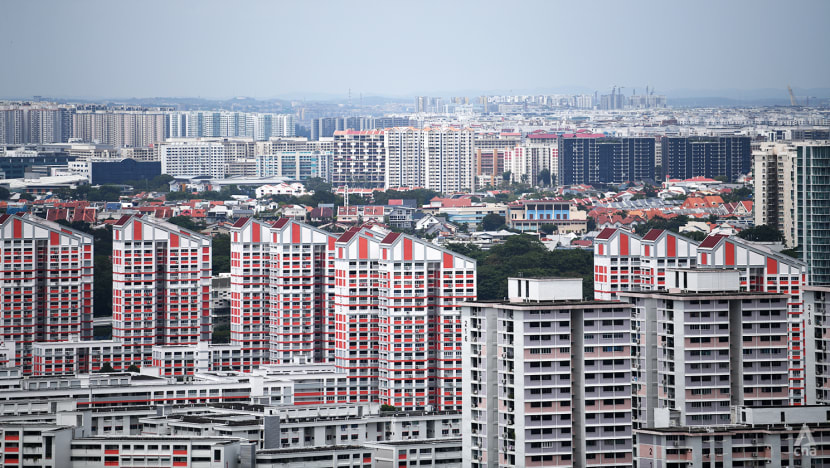Adequate or not? Analysts mixed on 6% subsidy clawback for Rochor flats under new prime location model

HDB flats and private properties in Singapore. (Photo: CNA/Calvin Oh)
SINGAPORE: A 6 per cent subsidy recovery – imposed on the resale of flats from the first housing project under the Prime Land Housing (PLH) model – has drawn mixed views from property analysts, with some believing it is “reasonable”, and others saying it is not high enough.
The clawback percentage, a highly anticipated detail in the new PLH model, was announced on Wednesday (Nov 17) for an upcoming project in Rochor.
It means that owners of upcoming units in the Rochor project will have to pay 6 per cent of the resale price or the flat’s valuation, whichever is higher, to the Housing & Development Board (HDB) when they sell their homes.
The clawback, which only applies to the first resale, was introduced to address concerns over extra subsidies leading to “excessive windfall gains”.
The Rochor project, which is expected to be completed in 2028, is part of HDB's November Build-to-Order (BTO) exercise.
Excluding conventional housing grants, prices for these units start from S$409,000 for a three-room flat and S$582,000 for a four-room flat. The project has 960 three-room and four-room flats.
“A MODEST SUM”
Ms Christine Sun, senior vice-president of research at OrangeTee & Tie, said the 6 per cent recovery rate “seems reasonable”.
This is because HDB resale flat prices have risen across the board over the past decade – and prices have gone up 9.1 per cent year-to-date, she said.
Given that the flats will hit the open market around 2038, after a longer construction period and 10-year minimum occupation period (MOP), she said: “There is a high probability for the PLH flats to achieve more than a 6 per cent price growth in 17 years.”
Breaking down the recovery rate, Ms Sun said that a four-room PLH flat that is sold for S$1.2 million in the future will have a clawback sum of about S$72,000. “The owner will still be able to enjoy a gross profit of at least S$500,000.”
She also said that the percentage “cannot be too high as the buyers face more stringent selling criteria and longer MOP, when compared to other BTO owners.”
Mr Ismail Gafoor, chief executive officer of PropNex, said the recovery rate of 6 per cent is "a modest sum considering the benefits arising from the location and the potential capital appreciation that the flats stand to gain." Nevertheless, he believes it is adequate.
Not all analysts felt the same way. Mr Nicholas Mak, head of research and consultancy at ERA Realty, said the percentage “seems a bit on the low side”.
Though there is no direct equivalent of the subsidy recovery in the private property market, Mr Mak said the closest tax would likely be the Seller’s Stamp Duty, ranging from 4 to 12 per cent, meant to deter speculative buying.
Thus, he had expected a “mid-point” figure of about 8 per cent.
Mr Mak added that the subsidy recovery goes some way to deflate the “lottery effect” of prime location flats. But based on estimates, “the buyers of PLH flats can still stand to make significant profit from their flats in the future,” he said.
For Mr Lee Sze Teck, head of research at Huttons, it is “difficult to say whether the clawback is fair” because there are no precedents.
He added: “We need to know how much the additional subsidy is. If it’s a six-figure amount, and the clawback is only 6 per cent, then we can make that judgment, but right now … one part of the equation is opaque.”
Authorities told CNA last month that the subsidy recovery rate will “reflect the extent of additional subsidies provided at launch” and the same rate will apply regardless of when the flat is resold in the future.
National Development Minster Desmond Lee had also cautioned that the percentage may be adjusted for other projects in future, depending on market conditions and the subsidies needed.
WHAT WILL DEMAND BE LIKE?
Of the units launched in the November BTO exercise, the flats in Rochor have the highest price range for a four-room flat, as well as the longest completion time of 71 months. The four-room units are also smaller than the usual 90 sq m.
Alongside the tighter resale restrictions imposed on these PLH flats, Ohmyhome analyst Mohan Sandrasegeran believes some buyers, such as younger couples, may turn their attention towards non-mature estates instead.
But overall, demand for the Rochor project is still expected to be strong.
OrangeTee & Tie’s Ms Sun said many buyers will still be attracted to the location, given the convenience and proximity to the central business district.
“Some may also like the prestige of living in the downtown area or (want) to enjoy the price appreciation in the long-term. Some may also like the ‘novelty of the whole PLH model’ and want to have the first-mover advantage of being the pioneer batch to own a PLH flat.”
PropNex’s Mr Ismail added that the units are still “relatively affordable”, and even comparable to the ones offered at Kallang and Whampoa, priced from S$511,000 (excluding grants) for a four-room unit.
Importantly, Mr Mohan said the application rate for this BTO project will set the benchmark for upcoming ones offered under the PLH model.
“This would also be a gauge for HDB to determine the positioning of such flats in the future,” he said.
















